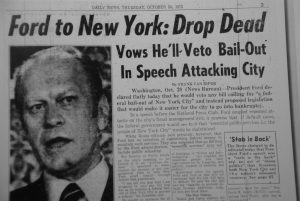You don’t know what you’ve got ’til newspapers are gone
BALTIMORE — That chill wind blowing into this city from 200 miles north might be the beating of the massive wings of the Angel of Death, now that she’s swept through the newsroom of New York’s Daily News and might be headed here.
Maybe you read about this last week – though, if you did, chances are you didn’t read about it in some daily newspaper. Who reads newspapers anymore? In America, not enough people to keep many of the dailies alive much longer.
But the Daily News was, in its day, an American icon. It had more readers than any paper in America. It had the great columnists like Jimmy Breslin and Dick Young.
 It was scruffy and impolite, like the city it covered. It had classic front-page headlines, like “Ford to New York: Drop Dead.”
It was scruffy and impolite, like the city it covered. It had classic front-page headlines, like “Ford to New York: Drop Dead.”
Remember that headline? All it did was turn around a presidential race.
They had another dandy the other day when Donald Trump tried to cover his disgraceful Helsinki performance with Vladimir Putin by changing a “would” to a “wouldn’t.” The News’ front page headline, next to Trump’s photo: “Lost in the Woulds.”
 But the paper’s glory days are long since behind it – much, unfortunately, like Baltimore’s Sun. The comparison is made because it’s the same cold-blooded corporation – The Chicago Tribune, now known as Tronc – which owns both papers (and others) and looks to make job cuts wherever they can, and never mind what it does to the quality of the newspaper or the quality of intelligent public discourse.
But the paper’s glory days are long since behind it – much, unfortunately, like Baltimore’s Sun. The comparison is made because it’s the same cold-blooded corporation – The Chicago Tribune, now known as Tronc – which owns both papers (and others) and looks to make job cuts wherever they can, and never mind what it does to the quality of the newspaper or the quality of intelligent public discourse.
A week ago in New York, they cut the remaining Daily News newsroom staff in half. They’ve now got fewer than a hundred people where they once had hundreds who were out there covering the city’s cops and courts and schools and neighborhoods. Their sports staff, once the pride of the paper, was cut from 35 to 9.
It’s the same in Baltimore. In The Sun’s newsroom, they once had more than 400 people. Under Tronc, they’re down to about a hundred. In August, they’re due to move out of their once-bustling Calvert Street offices downtown, over to a mostly-deserted Port Covington area of south Baltimore. The old building is simply too big and too costly for such a depleted number of people.
As everybody knows, the cuts reflect dwindling numbers of readers. The Daily News’ circulation was once 2.5 million. Now it’s down to about 200,000 in a city of 8.5 million people. The Sun prefers not to discuss its circulation numbers, nor its advertising figures.
All of this is bad for the two newspapers and reflective of what’s happening across modern America.
Richard Cohen, the veteran Washington Post columnist, once wrote, “Every journalist’s life is a walk through newspaper graveyards. The big dailies are the dinosaurs of our era. They thrived once. Their publishers smoked big cigars and their editors got the best tables in restaurants and the papers hit the front porch hard and heavy with ads.
Kids delivered them and adults worked for them and old men drew their pensions from them. They were a way of life, monuments in newsprint, but the way of life changed and the papers got weak and then sick and then died.”
 Cohen wrote this as a lament when Washington’s Star newspaper died. Take note that he wrote it in 1981. America’s newspapers have been twitching and convulsing and dying for a long time.
Cohen wrote this as a lament when Washington’s Star newspaper died. Take note that he wrote it in 1981. America’s newspapers have been twitching and convulsing and dying for a long time.
Some of us around here remember when The Sun was big enough, and fat and profitable enough, to have a sister newspaper, The Evening Sun, where H.L. Mencken wrote a lot of his stuff. Some of us still remember The News American, with its home-town guys like Lou Azrael and John Steadman.
All are gone, just ghostly memories now.
And all are remembered for more than sentimental reasons. Newspapers used to set the agenda for the day. They’re the only ones with enough people to cover actual beats, to dig into the details of things, to examine the actions behind the bullshit press conferences and P.R. announcements.
You remove actual reporters, you’re left with local TV news operations, where they don’t know what to report if they don’t have a weather emergency to lead the program. And you’re left with websites and bloggers, where it’s one person at a time trying to pierce the noise and the government flacks and the public relations machinery to try and make sense of it all.
You think it doesn’t matter that newspapers are failing? Wait until they’re gone. Then you’ll really feel the pain.

Michael Olesker, columnist for the News American, Baltimore Sun, and Baltimore Examiner has spent a quarter of a century writing about the city he loves.He is the author of several books, including Michael Olesker’s Baltimore: If You Live Here, You’re Home, Journeys to the Heart of Baltimore, and The Colts’ Baltimore: A City and Its Love Affair in the 1950s, all published by Johns Hopkins Press.
